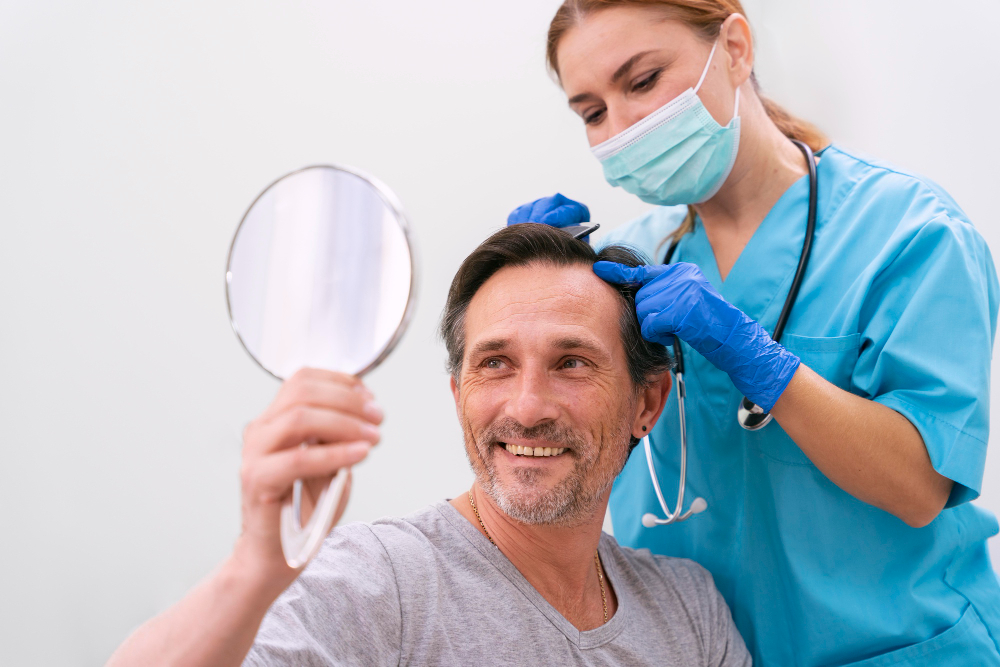Hair transplant clinic in Nice
Get a dazzling, confident hair look with our state-of-the-art Hair Transplant Centre.
Tailor-made hair, eyebrow and beard transplant solutions to reveal your natural beauty.
The Hair Transplant Clinic in Nice is the hair transplant specialist in Nice.
It is a hair restoration procedure that offers a glimmer of hope to people suffering from androgenetic alopecia, diffuse hair loss or scarring.

From €2,000 all inclusive

Hair clinic in Nice : Hair, Eyebrow and Beard Transplants
We welcome you to the Hair Clinic in Nice, France, your trusted destination for a radiant, confident appearance. Our highly qualified hair surgeons offer you first-class hair, eyebrow and beard transplant solutions, eyebrow and beard transplant solutions.
If you want to fill in bald spots, redefine your eyebrows or thicken your beard, we put modern facilities at your disposal to achieve natural, aesthetic results. Your satisfaction and well-being are our top priorities.

Our warm and caring team will guide you through the process, answering all your questions and providing detailed information on the different hair transplant options available. Thanks to our cutting-edge techniques, such as follicular grafting and micrografting, we can create impeccable results, perfectly tailored to your needs and morphology.
At the hair transplant center, we guarantee you a pleasant, safe and successful experience. Make an appointment today for a hair transplant in Nice and let us help you regain a dazzling, eye-catching appearance.
Hair transplant in Nice: before / after

Free initial consultation
Reveal your true hair potential with our Hair Transplant Centre. Special offer: First free consultation to discover the best hair, eyebrow and beard transplant solutions.

Make an appointment
By phone : +33(0) 4 89 33 00 33
By email : contact@nicehairclinic.com
Or send us a message :
Hair Transplants: Techniques, Results and Baldness Studies
Baldness, a problem that affects many people around the world, can have a significant impact on self-esteem and self-confidence.
Fortunately, hair transplants have become a popular solution for those looking to regain a thick, natural head of hair.
In this article, we will explore the different hair transplant techniques, the results that can be expected, and some relevant studies on baldness.
FUE hair transplant techniques in Nice are among the most advanced and offer long-lasting results. Hair density is a key factor taken into account during each procedure. The number of grafts required varies according to each specific case, but our team makes sure to optimize this figure to guarantee natural and harmonious results.
Hair Transplant Techniques in Nice
Follicular Unit Extraction (FUE ):
FUE is one of the most common hair transplant techniques. It involves extracting individual hair follicles from a donor area, usually located at the back of the head, then transplanting them to balding areas. This method is renowned for offering natural results and leaving only small , linear scars. Local anesthesia is used to ensure maximum comfort during the procedure.
Follicular Unit Transplantation (FUT):
FUT involves taking a strip of scalp from the donor area, cutting it into follicular units and transplanting them into balding areas. Although this technique may leave a more visible scar, it is effective and can produce remarkable results.
Robotic Hair Grafting:
Technological advances have introduced robots capable of performing FUE more precisely and rapidly. These robots minimize the risk of human error and are increasingly used in hair transplant clinics.Body Hair Transplant (BHT ):
For people with a limited donor area, this method allows body hair, such as chest or leg hair, to be used for transplantation. Although less common, it may be an option for some patients.
Hair Transplant Results
Hair transplant results vary from person to person depending on a number of factors, including the technique used, the quality of the follicles harvested and the skill of the surgeon. However, in most cases, patients can expect a significant improvement in their appearance.
Hair regrowth can take several months after the transplant, as the transplanted follicles go through a dormant phase before starting to grow again. Once regrowth is complete, the hair is generally permanent and behaves like natural hair.
Patients should follow their surgeon’s post-operative recommendations to achieve the best results and minimise the risk of infection or complications.
Baldness studies
Numerous studies are exploring the causes of baldness and ways to treat it. Here are some of the key findings :
- Genetics: Baldness has a significant genetic component. Men whose parents have suffered from baldness are more likely to develop this problem. Studies have identified specific genes associated with hair loss.
- Hormones: Hormones play a crucial role in baldness. Increased levels of the male hormone dihydrotestosterone (DHT) can cause hair follicles to miniaturize, leading to baldness in men.
- Drug treatments: Scientists have developed drugs such as minoxidil and finasteride to slow or reverse hair loss. These treatments are often combined with for best results.
Hair transplantation is now an effective solution for those battling baldness. Various techniques offer options to suit different needs. Results can be highly satisfactory, provided you consult a qualified surgeon and follow the post-operative recommendations to optimize results.
Why choose the FUE hair transplant clinic in Nice?
Our clinic stands out for its expertise in hair implants and its mastery of the most modern techniques.
Each patient benefits from personalized monitoring to maximize results and guarantee total satisfaction.
Our team uses exclusively the latest generation equipment to minimize risks and ensure rapid recovery.
Post-operative tips to optimize your results
After your hair transplant procedure in Nice, it is essential to strictly follow the post-operative recommendations provided by our medical team.
This includes specific care for the scalp, as well as particular attention to protection against external aggressions.
These precautions ensure successful integration of the grafts and promote healthy, long-lasting regrowth.







